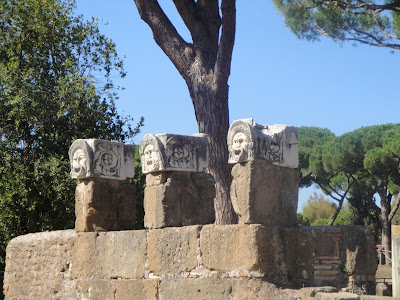Ostia Antica is one of the best preserved Roman archaeological sites and is only about a 30 minute train ride from Rome. However, it is not heavily visited as most people focus on going to the ruins in Pompeii. The city dates back to 400BC - 200BC and reached its peak in the 3rd century AD with about 75,000 residents. Ostia Antica was a port city and a city of commerce.
Mother nature struck Ostia with earthquakes and tsunamis in the 4th century and combined with the natural changes in the river and the collapse of the Roman Empire, the city became less and less important. Most of the marble was taken from Ostia Antica between the 11th and 14th centuries and overtime silt filled in the rest of the town. In the 1800's and 1900's the area was excavated.
The daughter checking out one of the graves outside the city walls (where Romans buried their dead)
A random stature in the cemetery
The main road Decumanus Maximus (which is not stroller friendly) that lead to Rome with carriage paths worn in
The original inscription of the main gate.
Walking on a 2000 year old mosaic
The baths of Neptune were built in the 100's and contain a mosaic of thousands of tiles, a spectacular site to say the least
Housing and shops
The theater as seen from the main road
A few interesting statues that can be seen from theater
A view looking back down the main road from the theater
A view of the Square of the Guilds where most of the commerce in town took place
The theater held 4,000 people and the bottom three rows are made of marble.
The photo below shows the layout of one of the many shops along the Square of the Guilds. In front of each of the shops is a Latin description of the shop and mosaic showing what the shop sold for the illiterate. This was a shipping shop.
This shop sold fish
This lava millstone is one of many that remain in the mill. It is comprised of two pieces and was turned by horses attached to poles going through the hole in the side.
The remains of an apartment building
A menu on the wall inside of the tavern
The L shaped bar inside the tavern
The metal tracks at the top of the doorway enabled the tavern to have sliding doors
A view of the city from the third story of an apartment building
Looking down at the tavern from the apartment building
Looking up at the apartment building from the tavern
The Grand Temple which was once covered in a marble veneer
The 20 seat bathroom, each seat contained a stick with a sponge (no toilet paper) and the aqueduct below took the waste away
One of the statues found at Ostia Antica which is housed in the on site museum
An early version of lady liberty
Some of the coffins had incredible detail
Another bath house




























No comments:
Post a Comment